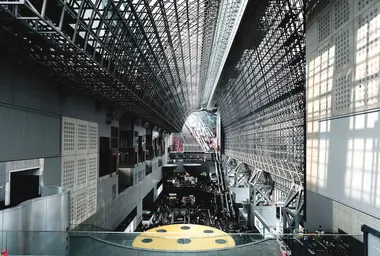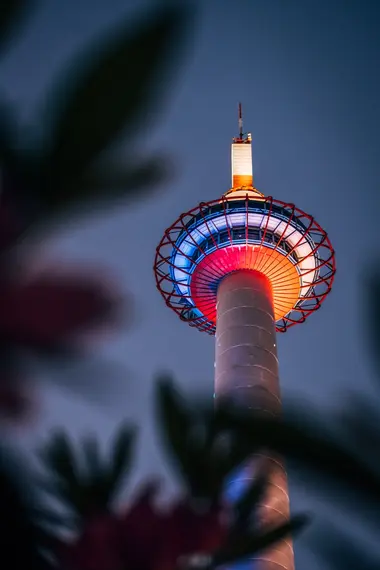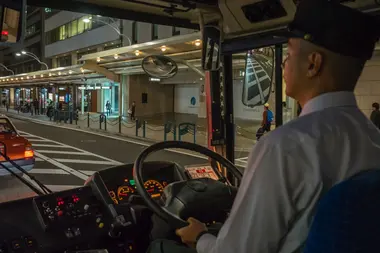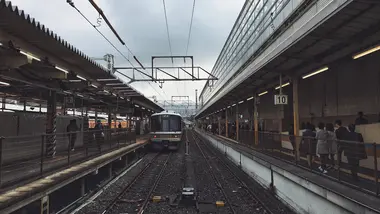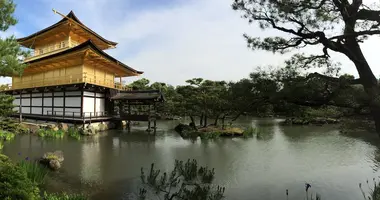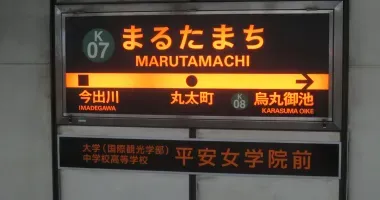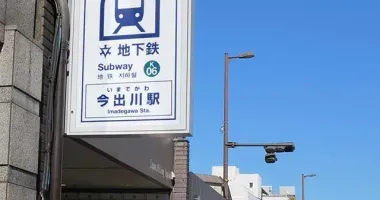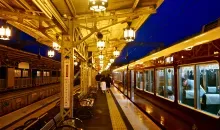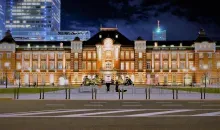Kyoto Station
Kyoto Station: find information on Kyoto Station including rail services from Kyoto Station, the Kyoto subway and trains to Kansai international Airport (KIX).
Kyoto Station is located in the south of Kyoto city at the end of the north-south Karasuma dori and just south of the east-west Shichijo dori. Kyoto Tower is directly opposite the main Central Exit.
Opened in 1997 to celebrate the 1,200th anniversary of the foundation of Kyoto (Heian-kyo) as the capital of Japan, the 15-story, glass-plated gray monolith, was designed by Hiroshi Hara.
Kyoto receives nearly 50 million tourists a year, 99% of them domestic, Japanese visitors on day-trips, and it certainly would seem a huge station is necessary to deal with them all and compared with Nagoya Station or Tokyo Station, Kyoto Eki does not have a packed, rushed feel due to its size.
Hara's ambitious design replaced an ugly 1950's concrete building, after the quaint, though aging Renaissance style structure, built in 1914 had burnt down in 1952. This in turn had superseded the original 1878 Meiji-era Kyoto Station.
Kyoto Station's stats are impressive - it comprises a huge 60 meter tall atrium, measures 470 meters from east to west, with a total floor space of 238,000 square meters. The Kyoto Station's building includes a department store, the Granvia Hotel, a theater, exhibition space, a museum as well as numerous shops and restaurants. The Sky Garden on the top 15th floor is a pleasant roof garden with incredible views of the city. Directly outside the station is Kyoto Tower, which is illuminated at night.
The Kyoto Eki Museum is on the 7th floor of Kyoto Station and is part of the Isetan Department Store.
The main Kyoto Tourist Office is on the second floor of the station and has a vast amount of information on Kyoto and English- Korean- and Chinese-speaking staff who can help you find accommodation and provide advice for onward travel and upcoming events and festivals in Kyoto.
Just across from the Kyoto Tourist Office is a room full of coin lockers, though they are often full, so visitors may want to make use of the baggage storage and luggage forwarding services at the Kansai Tourist Information Center on the 3F of Kyoto Tower opposite the main exit of Kyoto Station. Baggage storage is 500 yen per day often reduced to 300 yen.
There is also a Baggage Room (荷物一時預り所) on the B1 floor of Kyoto Station. This is open from 8am-8pm daily and charges 800 yen per day for each piece of luggage for up to 15 days. The limit is 30kg per piece of luggage no larger than 2m. Valuable goods such as computers or dangerous articles are not accepted. You can also have your luggage forwarded from here to a hotel in Kyoto or another destination in Japan for a fee.
There are more coin lockers outside the Hachijoguchi Exit and the Main Exit as well as opposite the main ticket gates on the second floor.
All Kyoto city buses radiate out from the station's bus terminal as well as the tourist specific Raku buses and there is a lot to see within easy walking or cycling distance of Kyoto Station itself.
Some handy buses include the #5 which runs through Okazaki and up to Shugakuin, the #206 to Kitaoji Bus Terminal, the #9 to Daitokuji Temple, the #28 to Arashiyama and Daikakuji, the #33 to Katsura Rikyu and the #205 to Kinkakuji Temple.
Kyoto Station is on the JR Tokaido Shinkansen route to Tokyo. Other JR lines radiating from Kyoto Station are the Nara Line south to JR Nara Station via Kizu and the San'in Main Line west to Shimonoseki through Fukui, Shimane and Yamaguchi Prefectures. The San'in Main Line also connects to Sonobe, Fukuchiyama and Kinosaki Onsen on its route west.The Kansai Airport Limited Express, Haruka, to Kansai International Airport (KIX) operates mainly from Kyoto Station with some through trains to Maibara.
There are frequent Special Rapid Services to Osaka, Sannomiya Station in Kobe and Himeji. The JR Ocean Arrow runs from Kyoto Station to Shingu in Wakayama Prefecture stopping at Shin Osaka, Tennoji and Wakayama stations. Overnight services passing through Kyoto Station include the Kitaguni train to Niigata and the Twilight Express to Sapporo. Both trains originate in Osaka. The Kintetsu Nara Line offers trains between Kyoto Station and Nara Kintetsu Station. Kyoto Station is also on the Karasuma subway line running north-south through the city.
Kyoto Station is an important bus terminus for buses to various destinations in the Kansai as well as Highway buses to Nagoya, Tokyo and other major destinations.
Higashi and Nishi Honganji Temples and Shosei-en Garden (Kikokutei) directly to the north, Sanjusangendo Temple and the National Museum to the east across the Kamo River, Toji Temple and its famous flea market to the south and the Umekoji Steam Locomotive Preservation Hall to the east. For old station buffs, Umekoji Steam Locomotive Preservation Hall just outside Umekoji Park preserves Nijo Station, the oldest wooden railway station in Japan, which was built in 1904 and replaced in 1996 by an equally fine modern building.
Shopping & Dining at Kyoto Station
Kyoto Station building includes the Isetan Department store and the Porta Underground Shopping Center. There are also a number of restaurants, cafes, a juice bar and an Irish-style pub, Man in the Moon (at the Hachijoguchi Exit). Specialist shops and restaurants in the station building include the Fukujuen Japanese tea shop, the Cento Cento Italian restaurant, Kyoto Ramen Koji and the Cube restaurant. There are branches of both BIC Camera and Yodobashi Camera near Kyoto Station for cameras, computers, electronics and cellphones.
Hotels Near Kyoto Station
The area around Kyoto Station both around the north Central and south Hachijoguchi exits has a number of hotels. Our recommended hotels near Kyoto Station include the following budget, mid-range, and luxury options:
Piece Hotel Sanjo is a renowned budget hotel very near Sanjo Station, in the heart of Kyoto. Modern, clean and minimalist, Piece Hotel Sanjo offers truly budget domitory accommodation, as well as compact private rooms. English- and Chinese-speaking staff make foreign guests feel extra welcome. Breakfast included. Nice communal lounge.
22 Pieces opened in 2017, and is a boutique style hotel in a prime location right near Kyoto Station. Enjoy meticuous modernity in big spacious guest rooms, each with a wonderful view of Kyoto. The cool minimalist vibe, outstanding facilities and helpful staff ensure a pleasant day in the lap of contemporary comfort that only enhances your enjoyment of this ancient city. Very reasonable rates for what you get.
Hotel Granvia Kyoto offers real comfort and convenience, almost forming part of Kyoto Station. Spacious, tasteful, quiet, fully fitted out rooms (even a coffee machine in the suites!) make for the ulimate relaxation after a day of sightseeing. Comfort, convenience, cleanliness, great cuisine and impeccable service make this hotel a popular upmarket choice.

